Bhutan, a mystical Himalayan kingdom, is renowned for its stunning landscapes, rich cultural heritage, and spiritual sites. The top places to visit in Bhutan offer a blend of natural beauty, sacred monasteries, and vibrant traditions. From the iconic Tiger's Nest Monastery to the serene Phobjikha Valley, Bhutan's diverse attractions promise a memorable experience. Whether you're exploring Bhutan’s cultural landmarks, enjoying its breathtaking scenery, or visiting the best tourist destinations in Bhutan, each location offers a unique glimpse into the country’s charm. Use this Bhutan travel guide to discover the must-see places in Bhutan, its famous tourist spots, and plan the ideal Bhutan travel itinerary.
At Druk Holidays, we pride ourselves on being the best travel company to help you explore the top places to visit in Bhutan. Our expert guides are passionate about showcasing Bhutan's beauty, from the iconic Tiger's Nest Monastery to the breathtaking Phobjikha Valley. We ensure that every journey is crafted with care, allowing you to experience the best tourist destinations in Bhutan in a way that is both enriching and memorable. With personalized itineraries, we make sure you don't miss any of the must-see places in Bhutan, including its famous tourist spots and hidden gems. Trust Druk Holidays to create the perfect Bhutan travel guide, tailored to your preferences, ensuring an unforgettable adventure in this magical kingdom.
Paro Taktsang (Tiger’s Nest Monastery)
Perched dramatically on a cliffside, Paro Taktsang, commonly known as the Tiger’s Nest Monastery, is one of the most iconic and must-see places in Bhutan. This sacred Buddhist site offers visitors a blend of spirituality, adventure, and breathtaking natural beauty. A visit to the Tiger's Nest Monastery is an unforgettable experience that tops most travelers' Bhutan itineraries.
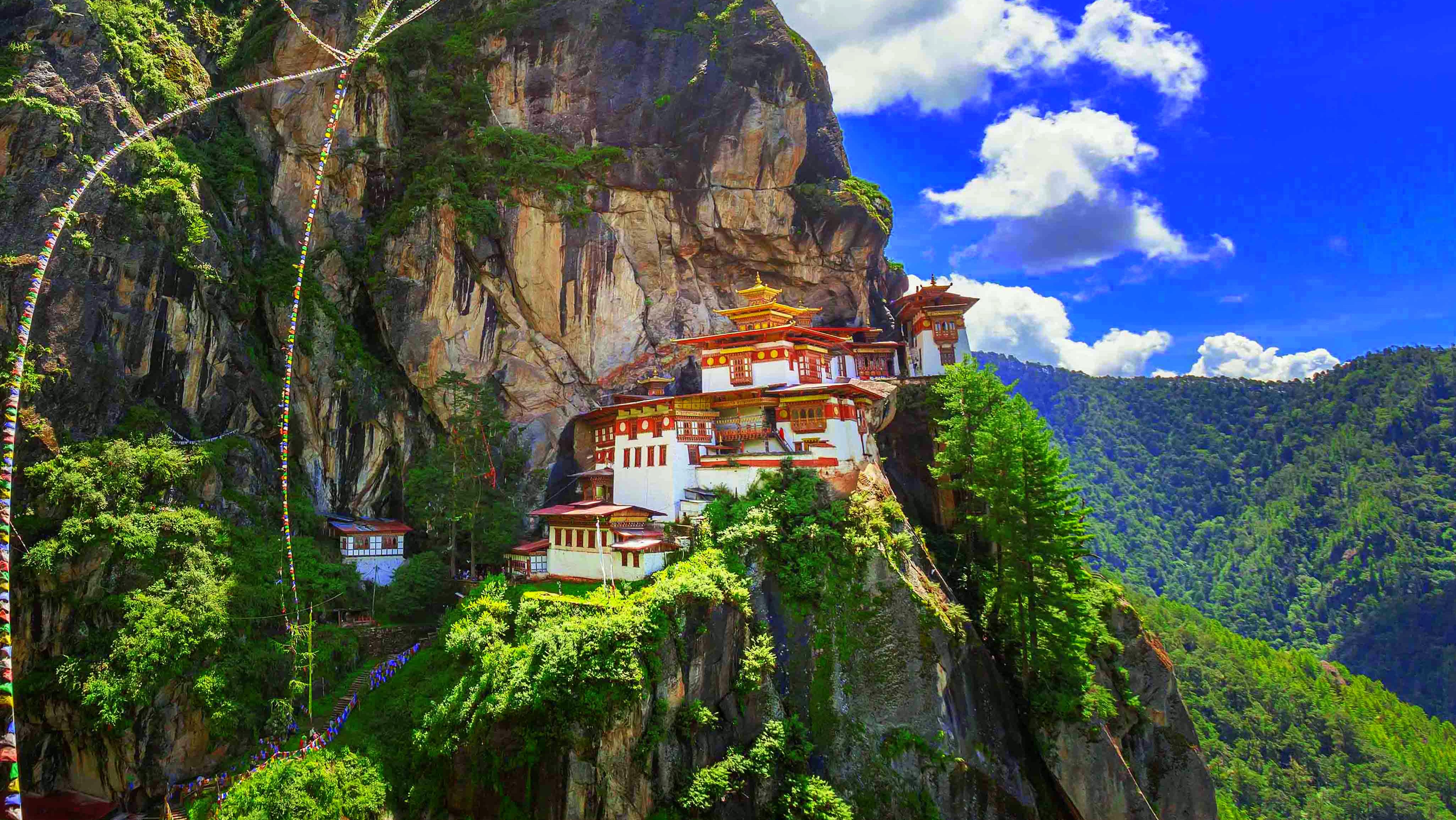
- Iconic Cliffside Location: Situated 3,120 meters above sea level, this monastery seems to defy gravity, clinging to a sheer rock face.
- Sacred Spiritual Site: It is believed that Guru Rinpoche flew to this site on the back of a tigress to meditate, making it one of the most revered pilgrimage destinations in Bhutan.
- Breathtaking Panoramic Views: The trek to the monastery offers stunning views of the Paro Valley and surrounding mountains.
- Challenging Hike: A moderate to difficult hike, the 2-3 hour ascent through lush forests is a rewarding journey for adventurers.
- Cultural Significance: The monastery is a symbol of Bhutanese Buddhism and houses ancient relics, murals, and meditation caves.
- Meditation Caves: Within the monastery, you can find sacred caves where Guru Rinpoche is said to have meditated.
- Serenity and Peace: The tranquil atmosphere of the monastery offers a perfect escape for reflection and spiritual exploration.
- Best Time to Visit: The ideal time to visit the Tiger’s Nest is from March to May and September to November, when the weather is most pleasant.
Visiting Paro Taktsang is not just a journey to one of the most famous tourist spots in Bhutan, but a deep dive into the country’s spiritual heritage. The combination of natural beauty and religious significance makes the Tiger's Nest Monastery a highlight of any Bhutan travel guide.
Thimphu
Thimphu, the capital city of Bhutan, offers a perfect blend of tradition and modernity, making it one of the top places to visit in Bhutan. Set in a picturesque valley, Thimphu is home to important Bhutan cultural landmarks, vibrant markets, and serene monasteries. This bustling city is the ideal place to experience Bhutanese culture while still enjoying modern comforts.
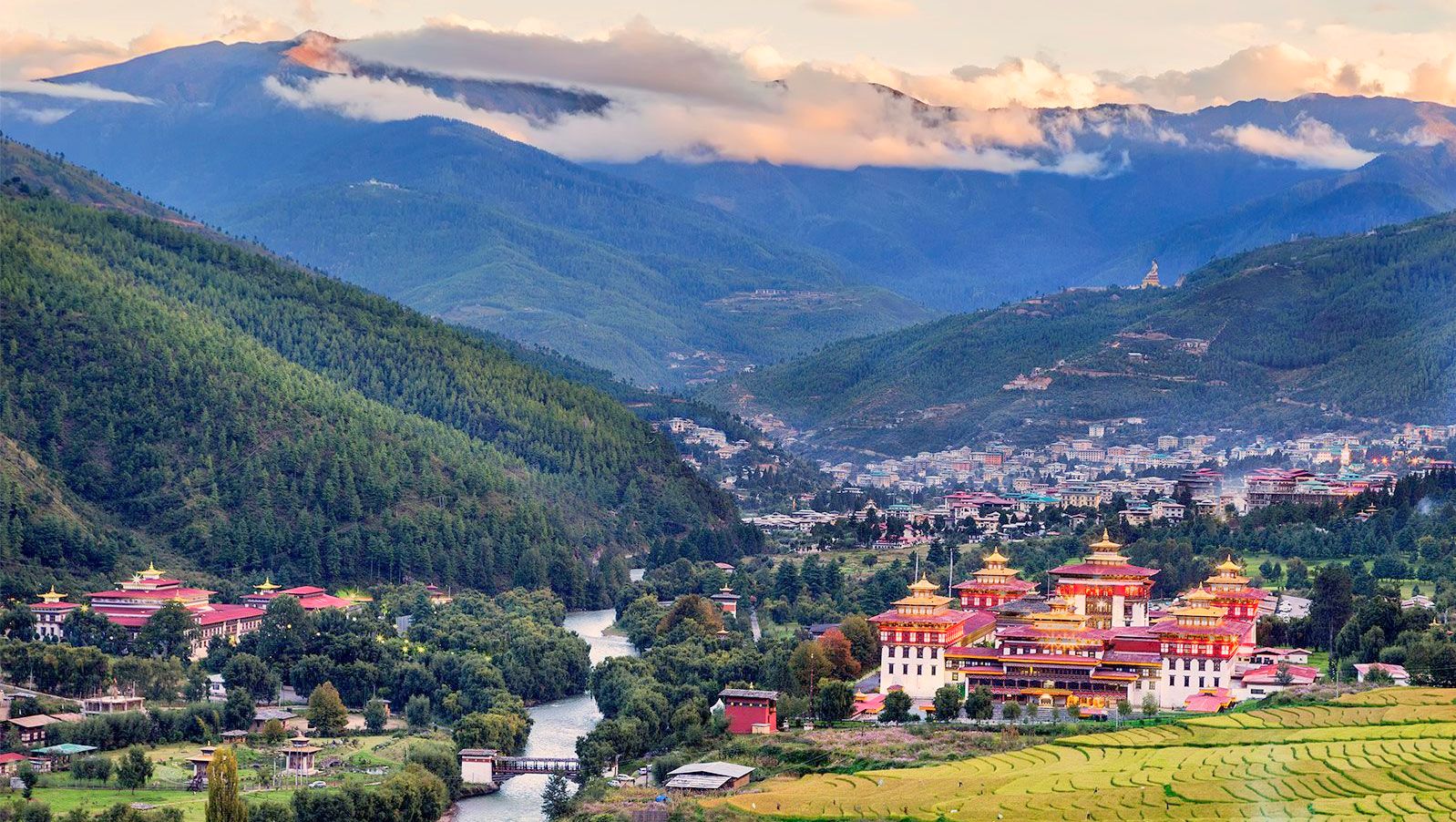
- Tashichho Dzong: A magnificent fortress and monastery, serving as the seat of Bhutan's government and home to the central monastic body.
- Buddha Dordenma: One of the world’s largest Buddha statues, this 169-foot bronze figure offers panoramic views of the valley.
- National Memorial Chorten: A sacred structure built in honor of the third king, it is a spiritual hub for locals, who perform daily prayers here.
- Folk Heritage Museum: A living museum that showcases Bhutanese traditions, rural life, and culture.
- Weekend Market: A vibrant local market where you can explore Bhutanese crafts, textiles, and produce.
- Changangkha Lhakhang: A centuries-old monastery where locals come to pray for protection and blessings for their children.
- Textile Museum: Dedicated to Bhutan’s rich tradition of weaving, offering insight into the country's heritage.
- Tranquil Parks: From serene parks like Coronation Park to the lush walks along the riverside, Thimphu offers numerous outdoor spots for relaxation.
As one of the best tourist destinations in Bhutan, Thimphu is not only the cultural and political heart of the country but also a fascinating place for travelers to dive into the local way of life. Whether you're exploring its famous tourist spots or strolling through its streets, Thimphu is an essential stop on any Bhutan travel itinerary.
Punakha Dzong
Punakha Dzong, often referred to as the "Palace of Great Happiness," is one of the most magnificent and historic fortresses in Bhutan. Nestled at the confluence of the Pho Chhu and Mo Chhu rivers, it’s a prime example of Bhutanese architecture and a key attraction for visitors. As a former capital, Punakha Dzong holds deep cultural and spiritual significance, making it a must-see place in Bhutan for history and architecture enthusiasts.
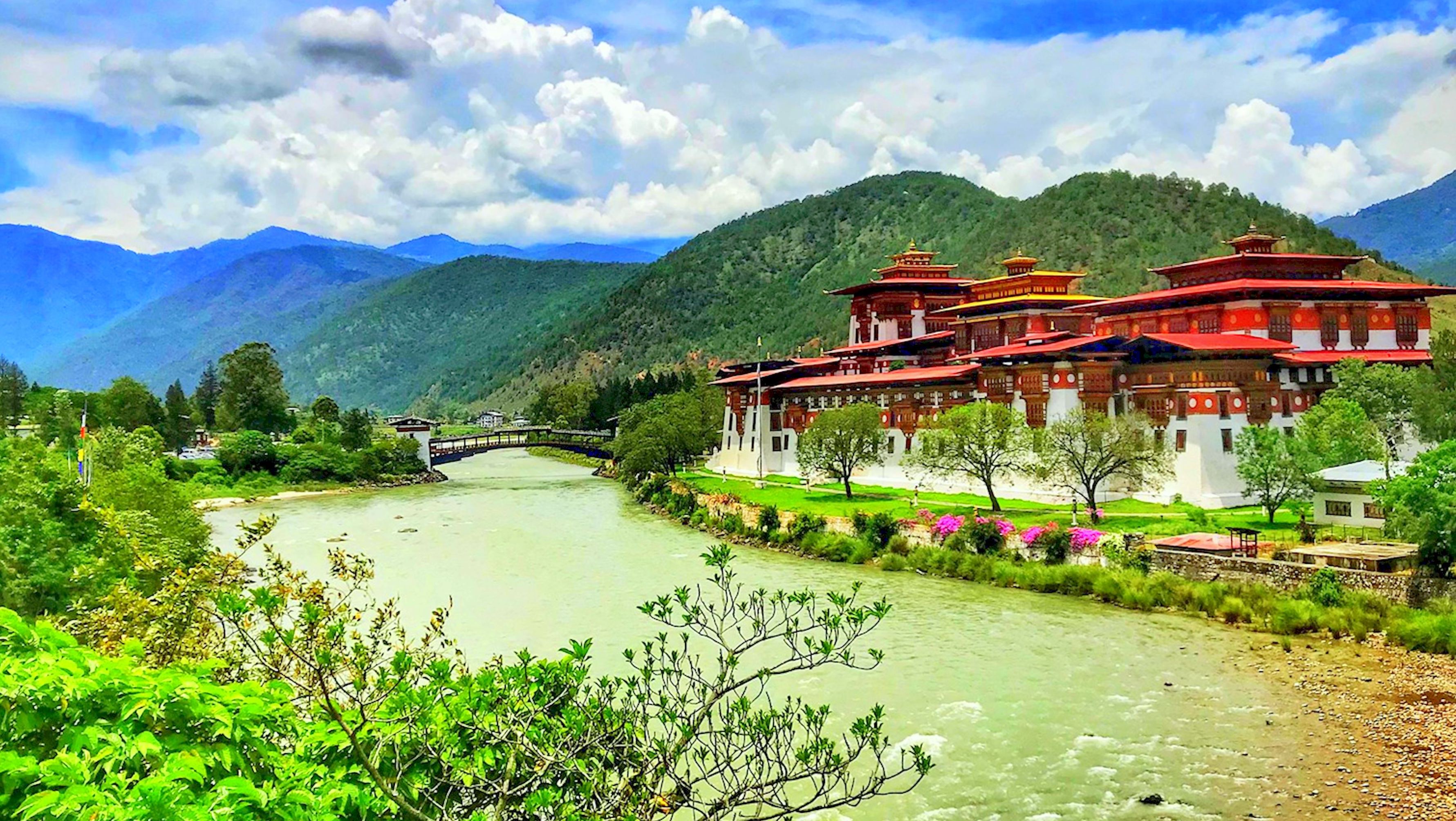
- Stunning Architecture: Punakha Dzong is renowned for its intricate woodwork, towering whitewashed walls, and impressive courtyards.
- Confluence Location: The dzong is beautifully situated where the Pho Chhu (male river) and Mo Chhu (female river) meet, offering scenic views of the surrounding landscape.
- Historical Significance: This dzong served as the administrative center of Bhutan until 1955 and continues to play a vital role in the country’s religious and political ceremonies.
- Sacred Relics: The dzong houses sacred relics of the Drukpa Lineage, as well as the embalmed body of Bhutan’s unifier, Zhabdrung Ngawang Namgyal.
- Punakha Suspension Bridge: A short distance from the dzong, this long, swaying suspension bridge offers breathtaking views of the valley and rivers.
- Annual Festivals: The dzong is the site of the annual Punakha Tshechu, a colorful religious festival celebrated with masked dances and traditional rituals.
- Beautiful Courtyards: Explore the tranquil courtyards of the dzong, which are meticulously maintained and surrounded by vibrant jacaranda trees during spring.
- Best Time to Visit: Spring (March to May) and autumn (September to November) are ideal for visiting when the weather is pleasant and the trees bloom around the dzong.
A visit to Punakha Dzong is not just about witnessing one of Bhutan’s most famous tourist spots, but also experiencing the spiritual essence of the country. Its architectural beauty and historical significance make it a highlight in any Bhutan travel guide and a key stop on your Bhutan travel itinerary.
Bumthang Valley
Bumthang Valley, often considered the spiritual heart of Bhutan, is a captivating region known for its serene landscapes, ancient monasteries, and rich cultural heritage. Nestled in central Bhutan, this picturesque valley is a treasure trove of Bhutanese history and spiritual significance, making it a top destination for travelers seeking an immersive cultural experience.
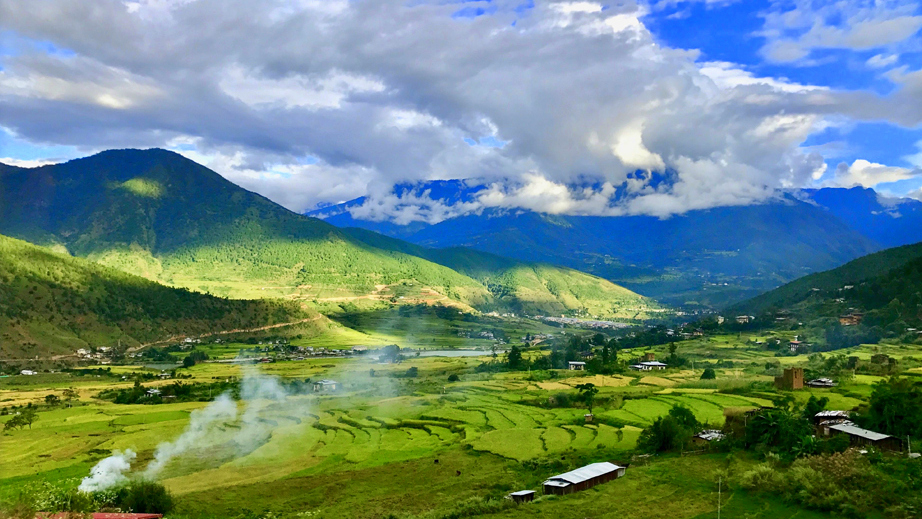
- Ancient Monasteries: Bumthang Valley is home to several historic monasteries, including Kurje Lhakhang, where Guru Rinpoche meditated, and Jakar Dzong, an impressive fortress with deep historical roots.
- Sacred Sites: The valley boasts several sacred sites, such as Jambay Lhakhang, which hosts the vibrant Jambay Lhakhang Drup festival, celebrating Bhutanese culture and spirituality.
- Traditional Architecture: Experience traditional Bhutanese architecture through the valley’s charming temples and historic buildings, which reflect the country’s rich cultural heritage.
- Scenic Beauty: The valley’s rolling hills, lush forests, and terraced fields offer stunning natural scenery, perfect for nature lovers and photographers.
- Local Culture: Discover the traditional lifestyle of the Bumthang people, known for their vibrant festivals, intricate handicrafts, and warm hospitality.
- Festivals: The annual Bumthang Tsechu, a colorful religious festival featuring traditional dances and rituals, is a highlight of the cultural calendar.
- Hiking Trails: Explore various hiking trails that offer breathtaking views of the valley and access to remote temples and monasteries.
- Best Time to Visit: The ideal time to visit Bumthang Valley is during the spring (March to May) and autumn (September to November) when the weather is pleasant and the valley’s beauty is at its peak.
Bumthang Valley is a must-see place in Bhutan for anyone interested in exploring the country’s spiritual and cultural roots. Its serene landscapes, historical sites, and vibrant traditions make it a standout destination in any Bhutan travel itinerary and a key highlight of Bhutan’s cultural landmarks.
Haa Valley
Haa Valley, one of Bhutan’s most enchanting and lesser-visited regions, offers a unique blend of stunning natural beauty and rich cultural heritage. Nestled in the western part of Bhutan, this serene valley is celebrated for its pristine landscapes, traditional architecture, and tranquil atmosphere, making it a top choice for travelers seeking a peaceful retreat.
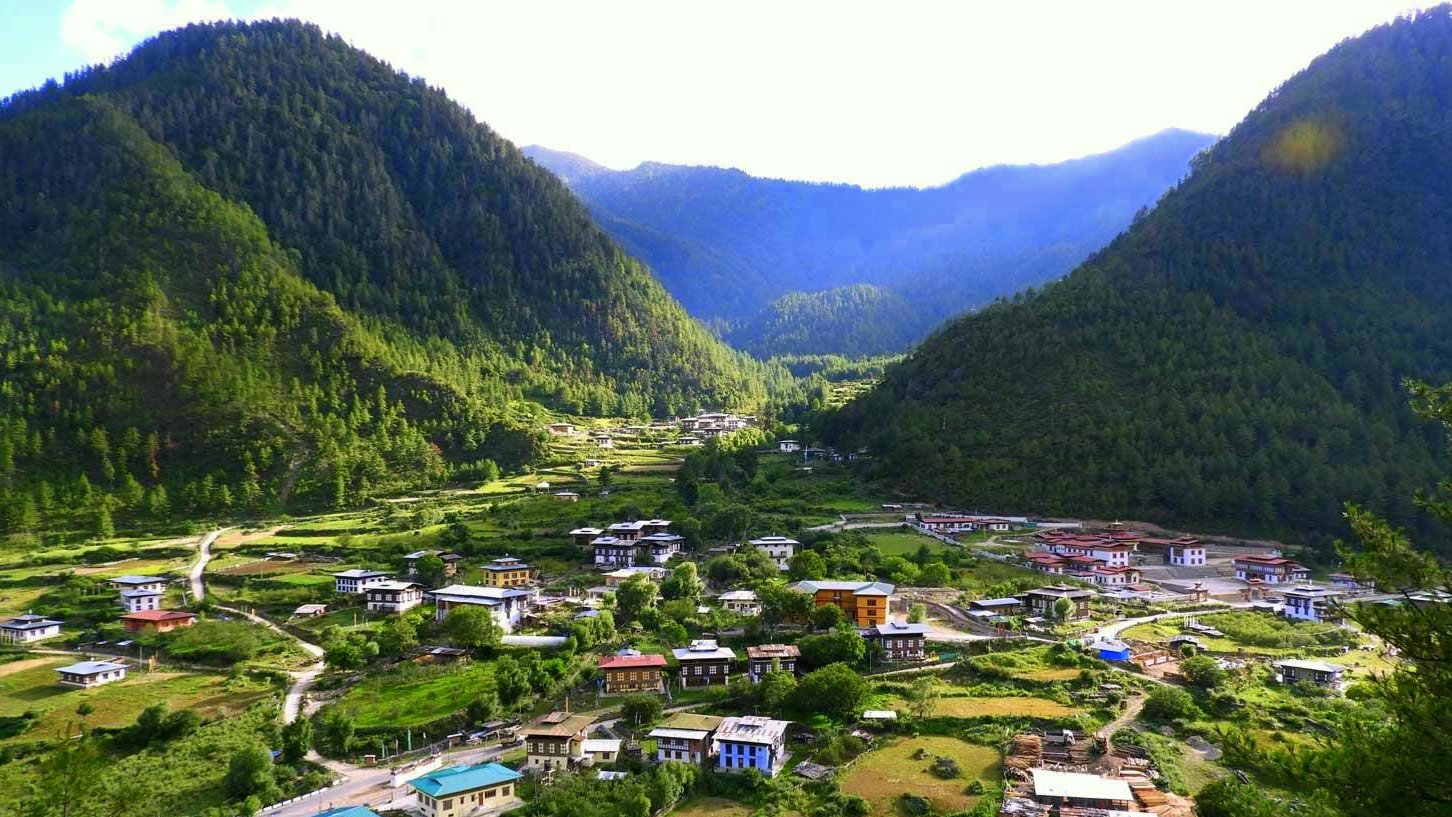
- Picturesque Landscapes: Haa Valley is known for its breathtaking views, including rolling hills, lush forests, and scenic meadows that provide a perfect backdrop for photography and relaxation.
- Traditional Villages: Explore the charming traditional villages of Haa, where you can witness Bhutanese rural life and experience authentic local culture.
- Lhakhang Karpo and Lhakhang Nagpo: These ancient temples are significant cultural landmarks in the valley, with Lhakhang Karpo (White Temple) and Lhakhang Nagpo (Black Temple) being central to local legends and traditions.
- Haa Summer Festival: Experience the vibrant Haa Summer Festival, which showcases traditional Bhutanese dance, music, and sports, offering a unique insight into the region’s cultural heritage.
- Peaceful Environment: The valley’s tranquil setting makes it an ideal destination for meditation and relaxation, away from the more frequented tourist spots.
- Hiking Opportunities: Enjoy various hiking trails that lead through the picturesque valley, offering stunning views and access to remote temples and natural sites.
- Bhutanese Architecture: The valley’s traditional Bhutanese buildings, including monasteries and farmhouses, reflect the region’s rich cultural heritage and architectural style.
- Best Time to Visit: The best time to visit Haa Valley is during the spring (March to May) and autumn (September to November) when the weather is mild and the valley is at its most beautiful.
Haa Valley is a must-see place in Bhutan for those looking to explore one of the country’s hidden gems. Its combination of natural beauty, cultural richness, and peaceful ambiance makes it a standout destination on any Bhutan travel itinerary and a memorable addition to your journey through Bhutan.
Phobjikha Valley
Phobjikha Valley, renowned for its breathtaking scenery and unique ecological significance, is a must-visit destination in Bhutan. Located in the central region of the country, this picturesque valley is a winter habitat for the endangered black-necked cranes and offers visitors an unforgettable blend of natural beauty and cultural richness.
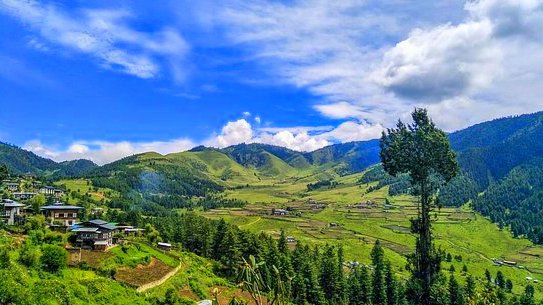
- Black-Necked Cranes: Phobjikha Valley is famous for being the winter home of the black-necked cranes, which migrate from the Tibetan plateau. Their presence adds a magical touch to the valley, especially during the annual migration season from October to March.
- Scenic Beauty: The valley’s stunning landscapes feature rolling meadows, lush forests, and dramatic mountain backdrops, providing perfect conditions for outdoor activities and photography.
- Gangtey Monastery: This important Buddhist monastery, perched on a hill overlooking the valley, offers panoramic views and insights into Bhutanese spirituality and architecture.
- Cultural Significance: Phobjikha Valley is known for its rich cultural heritage, including traditional Bhutanese farming practices and local festivals.
- Nature Trails: Enjoy serene nature walks and hikes through the valley’s well-maintained trails, which offer close encounters with its diverse flora and fauna.
- Phobjikha Valley Conservation: The valley is part of the Phobjikha Conservation Area, a protected region dedicated to preserving the unique ecological and cultural features of the area.
- Traditional Farmhouses: Visit traditional Bhutanese farmhouses scattered throughout the valley, where you can experience authentic local life and hospitality.
- Best Time to Visit: The ideal time to visit Phobjikha Valley is from October to March, during the black-necked cranes’ winter migration, and in spring (April to May) when the valley is lush and vibrant.
Phobjikha Valley is a top place to visit in Bhutan for nature enthusiasts and cultural explorers alike. Its unique combination of wildlife, stunning landscapes, and cultural richness makes it a standout destination in any Bhutan travel itinerary and a highlight among Bhutan’s scenic spots.
Dochula Pass
Dochula Pass, one of Bhutan's most scenic and culturally significant mountain passes, offers stunning panoramic views and a unique cultural experience. Located at an elevation of 3,100 meters (10,200 feet), this pass serves as a gateway to the central and eastern regions of Bhutan, making it a key highlight for any traveler exploring the country.

- 108 Chortens: The Dochula Pass is renowned for its 108 chortens (stupas), built in honor of Bhutanese soldiers who died in a 2003 military conflict. These chortens, adorned with colorful prayer flags, create a picturesque and solemn scene.
- Breathtaking Views: On clear days, the pass offers stunning views of the Himalayan mountain range, including the snow-capped peaks of Bhutan’s highest mountains such as Gangkhar Puensum.
- Druk Wangyal Lhakhang: A beautiful temple built in honor of the fourth king of Bhutan, which stands near the chortens. The temple’s architecture and serene environment add to the pass's spiritual atmosphere.
- Prayer Flags: The vibrant prayer flags that adorn the pass flutter in the wind, adding a splash of color and a sense of peace to the environment.
- Cultural Significance: The pass holds cultural importance as it is a site of religious and national significance, representing Bhutanese devotion and respect for their heritage.
- Photographic Opportunities: The combination of stunning Himalayan views, the chortens, and prayer flags provides excellent photographic opportunities.
- Refreshing Climate: The high altitude and crisp mountain air offer a refreshing change from the warmer valleys below, making it a pleasant stop during your journey.
- Best Time to Visit: The ideal times to visit Dochula Pass are during the spring (March to May) and autumn (September to November) when the weather is clear and the views are at their best.
Dochula Pass is a must-see place in Bhutan for its combination of breathtaking scenery and cultural heritage. Its stunning views, sacred sites, and peaceful ambiance make it a prominent stop on any Bhutan travel itinerary and a highlight among Bhutan’s scenic spots.
Chele La Pass
Chele La Pass is renowned for offering some of the most breathtaking panoramic views in Bhutan. Located at an elevation of 3,988 meters (13,083 feet), it is one of the highest motorable passes in the country. This pass, situated between Paro and Haa Valleys, is a highlight for travelers seeking stunning vistas and a tranquil escape into Bhutan's natural beauty.
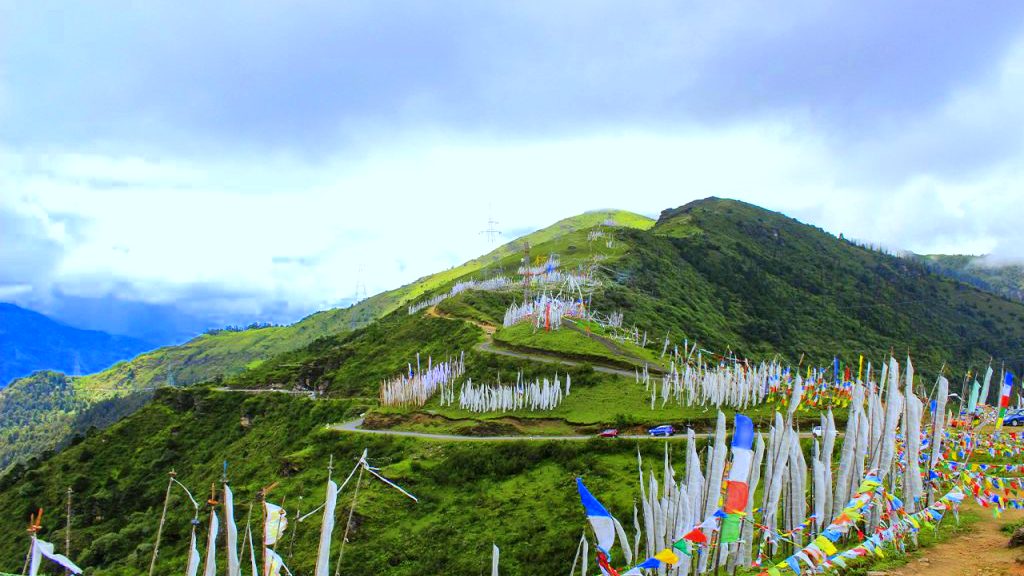
- Spectacular Views: Chele La Pass provides sweeping views of the majestic Himalayas, including glimpses of Bhutan’s highest peak, Mount Jomolhari, as well as other snow-capped peaks.
- Serene Environment: The pass’s elevated position and crisp mountain air offer a serene and peaceful environment, ideal for contemplation and relaxation.
- Prayer Flags: Vibrant prayer flags fluttering at the pass add a touch of color and spirituality, creating a visually striking and serene atmosphere.
- Mountain Flora: The surrounding areas are adorned with unique alpine flora and meadows, providing a beautiful contrast against the rugged mountain backdrop.
- Hiking Opportunities: There are several hiking trails in the vicinity that offer fantastic views and opportunities to explore the natural landscape further.
- Cultural Significance: The pass is a significant site for local Bhutanese, often visited for its spiritual and cultural importance, especially during special ceremonies and festivals.
- Photo Opportunities: The combination of dramatic mountain landscapes, colorful prayer flags, and alpine scenery makes it an excellent spot for photography.
- Best Time to Visit: The best times to visit Chele La Pass are during the spring (March to May) and autumn (September to November) when the weather is clear and the views are unobstructed.
Chele La Pass is a top place to visit in Bhutan for its breathtaking views, serene atmosphere, and cultural significance. It is an essential stop on any Bhutan travel itinerary, offering some of the most stunning and memorable experiences in the country’s scenic spots.
Gangtey Monastery
Gangtey Monastery, also known as Gangtey Goempa, is a significant religious and cultural landmark nestled in the heart of the Phobjikha Valley. This majestic monastery is a central feature of the valley’s spiritual landscape and a must-visit destination for those exploring Bhutan's rich heritage and serene environments.
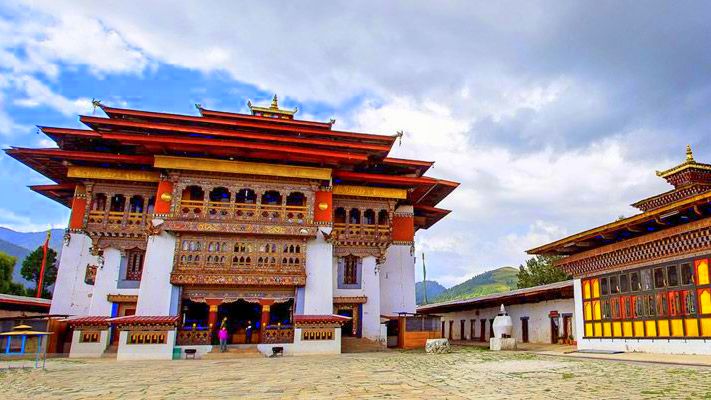
- Buddhist Architecture: Gangtey Monastery is renowned for its impressive traditional Bhutanese architecture, characterized by intricate woodwork, vibrant murals, and majestic courtyards.
- Spiritual Importance: The monastery is a prominent center for the Nyingma school of Tibetan Buddhism and serves as the residence of the Pema Lingpa lineage, adding to its spiritual significance.
- Cultural Festivals: The monastery hosts the annual Gangtey Tsechu, a vibrant festival featuring traditional dances, music, and rituals that draw visitors from across the country.
- Stunning Location: Perched on a hilltop overlooking the Phobjikha Valley, the monastery offers breathtaking views of the surrounding landscapes and is surrounded by lush pine forests and meadows.
- Cultural Insights: Visitors can explore various aspects of Bhutanese culture and religious practices through the monastery’s rich collections of artifacts, religious texts, and traditional artwork.
- Local Community: The monastery plays a vital role in the local community, serving as a center for education and spiritual guidance for the residents of the Phobjikha Valley.
- Wildlife Spotting: The area around the monastery is a habitat for the endangered black-necked cranes, which can often be seen during their winter migration season.
- Best Time to Visit: The ideal times to visit Gangtey Monastery are during the spring (March to May) and autumn (September to November), when the weather is pleasant and the surrounding scenery is at its most vibrant.
Gangtey Monastery is a top place to visit in Bhutan for its combination of spiritual significance, architectural beauty, and stunning natural surroundings. As a highlight of the Phobjikha Valley, it offers a profound experience for those interested in Bhutanese culture, making it a key stop on any Bhutan travel itinerary.
Chimi Lhakhang
Chimi Lhakhang, often referred to as the Fertility Temple, is one of Bhutan's most unique and culturally significant monasteries. Located in the Punakha District, this temple is renowned for its association with fertility blessings and its distinctive architectural style. It attracts both spiritual seekers and curious travelers looking to experience Bhutanese culture and traditions.
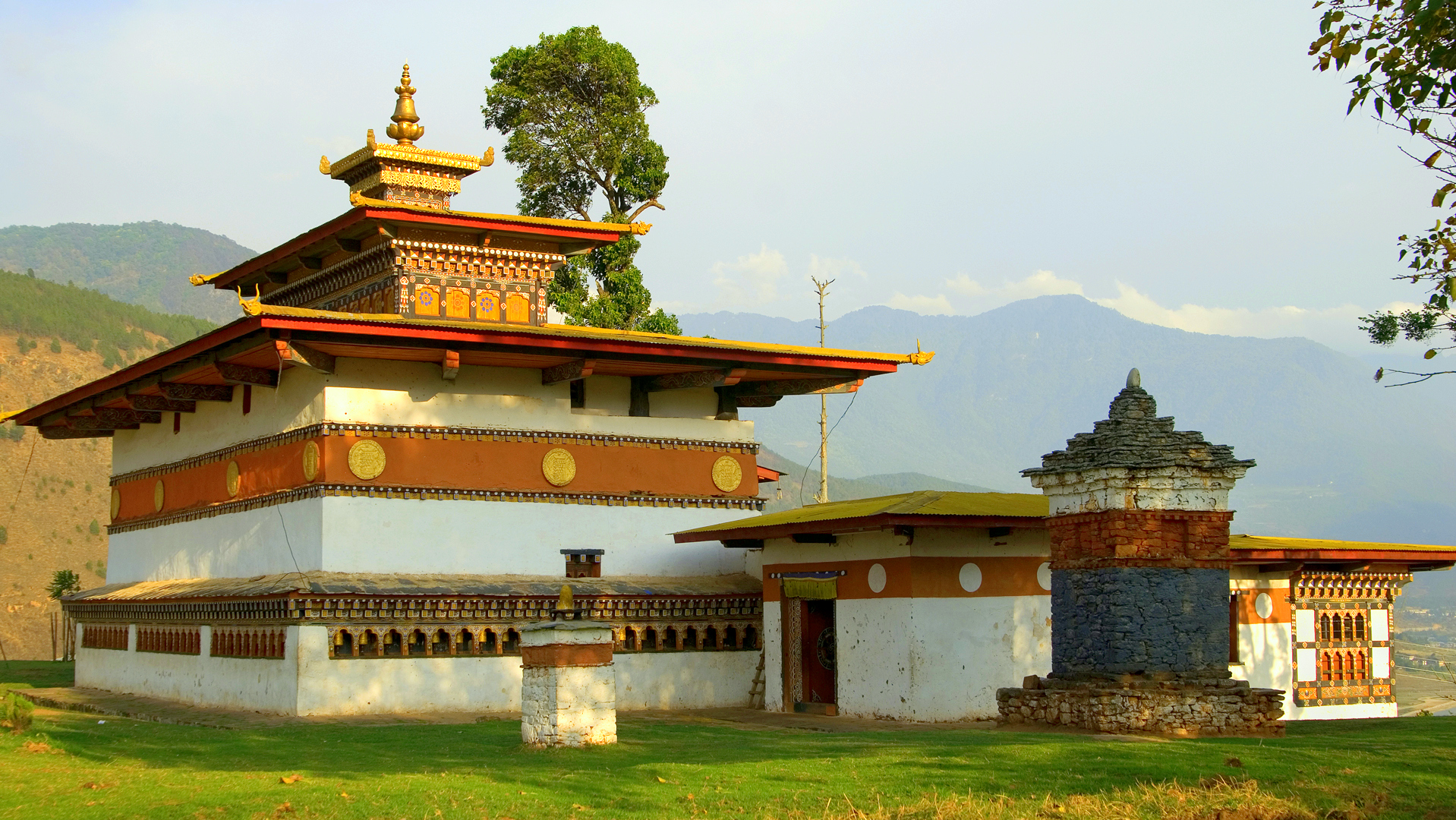
- Fertility Blessings: Chimi Lhakhang is famous for its fertility blessings, believed to help couples conceive and ensure the well-being of newborns. Pilgrims and visitors often seek blessings from the temple’s revered statues and relics.
- Unique Architecture: The temple features traditional Bhutanese architecture, including intricately painted walls, colorful murals, and a distinctive, simple yet elegant design that reflects Bhutanese religious art.
- Devotional History: The temple is dedicated to Lam Drukpa Kuenley, also known as the "Divine Madman," a revered monk known for his unconventional methods of teaching Buddhism through humor and unique rituals.
- Scenic Setting: Set amidst picturesque rural landscapes, Chimi Lhakhang is surrounded by lush rice fields and rolling hills, offering a tranquil and scenic environment for reflection and meditation.
- Local Traditions: The temple is deeply embedded in local traditions and customs. Visitors often witness traditional Bhutanese ceremonies and practices that are integral to the region’s spiritual life.
- Cultural Significance: The temple serves as a center for cultural and religious activities, including various festivals and rituals that highlight Bhutanese heritage and spiritual practices.
- Accessible Location: Located a short distance from the town of Punakha, Chimi Lhakhang is easily accessible, making it a convenient stop on a tour of the region.
- Best Time to Visit: The ideal times to visit Chimi Lhakhang are during the spring (March to May) and autumn (September to November) when the weather is pleasant and the surrounding landscapes are at their best.
Chimi Lhakhang is a must-see place in Bhutan for its unique blend of spirituality, cultural significance, and stunning rural setting. It offers a distinctive experience that highlights the rich traditions and beliefs of Bhutan, making it a memorable addition to any Bhutan travel itinerary.
Exploring the Top 10 Places to Visit in Bhutan offers a captivating journey through one of the world’s most enchanting and culturally rich destinations. From the sacred heights of Tiger’s Nest Monastery to the serene beauty of Phobjikha Valley and the historic significance of Chimi Lhakhang, each site provides a unique glimpse into Bhutan’s heritage, spirituality, and natural splendor. Whether you’re marveling at the stunning vistas from Dochula Pass, experiencing the tranquil ambiance of Gangtey Monastery, or discovering the cultural treasures of Bumthang Valley, Bhutan’s diverse attractions promise unforgettable experiences. With its blend of scenic spots, cultural landmarks, and spiritual sites, Bhutan invites travelers to immerse themselves in its profound beauty and timeless traditions. Incorporating these must-see places into your Bhutan travel itinerary ensures a journey filled with discovery, inspiration, and lasting memories.
FAQs of the Top 10 Places to Visit in Bhutan
Q: What are the top places to visit in Bhutan?
A: The top places to visit in Bhutan include Tiger’s Nest Monastery (Paro Taktsang), Thimphu, Punakha Dzong, Bumthang Valley, Haa Valley, Phobjikha Valley, Dochula Pass, Chele La Pass, Gangtey Monastery, and Chimi Lhakhang. Each of these destinations offers unique experiences and showcases Bhutan’s rich culture and natural beauty.
Q: What is the best time to visit Bhutan?
A: The best times to visit Bhutan are during spring (March to May) and autumn (September to November). These seasons offer pleasant weather, clear skies, and vibrant landscapes, making them ideal for sightseeing and outdoor activities.
Q: What should I pack for a trip to Bhutan?
A: When traveling to Bhutan, pack layers of clothing to accommodate varying temperatures, especially in higher altitudes. Essentials include warm clothing, sturdy hiking shoes, a rain jacket, sunscreen, a hat, and any personal medications. Also, don’t forget a camera to capture the stunning landscapes and cultural landmarks.
Q: Is Bhutan a good destination for hiking and trekking?
A: Yes, Bhutan is an excellent destination for hiking and trekking. Popular trails include the Tiger’s Nest Monastery hike, the Druk Path Trek, and the Jomolhari Trek. These trails offer breathtaking views, cultural experiences, and the opportunity to explore Bhutan’s diverse landscapes.
Q: Are there any cultural festivals I should attend while in Bhutan?
A: Yes, Bhutan is known for its vibrant festivals. Notable ones include the Paro Tsechu, Thimphu Tsechu, and Bumthang Tsechu. These festivals feature traditional dances, music, and rituals, providing deep insights into Bhutanese culture and spiritual practices.
Q: How can I get around Bhutan?
A: Getting around Bhutan typically involves a combination of domestic flights, private vehicles, and local taxis. Most tourists hire a private driver or tour guide for convenience and to ensure a smooth travel experience, as public transportation options are limited.
Q: Are there any entry requirements for visiting Bhutan?
A: Yes, visitors to Bhutan generally require a visa, which is arranged through a licensed Bhutanese tour operator. Additionally, travelers must book their trip through a licensed travel agency, and all tour arrangements should be made in advance.
Q: What are some must-see cultural landmarks in Bhutan?
A: Must-see cultural landmarks in Bhutan include Punakha Dzong, Gangtey Monastery, and Chimi Lhakhang. These sites offer insights into Bhutanese architecture, history, and religious practices.
Q: Is Bhutan a safe destination for travelers?
A: Yes, Bhutan is considered a safe destination for travelers. The country has low crime rates, and the Bhutanese people are known for their hospitality and friendliness. However, travelers should always exercise common sense and adhere to local customs and regulations.
Q: Can I visit Bhutan on a budget?
A: While Bhutan is generally considered a premium travel destination due to its daily tariff system, it is possible to manage a budget trip by planning ahead and traveling during the off-season. Opt for group tours or budget accommodations to help reduce costs while still enjoying the country's attractions.



